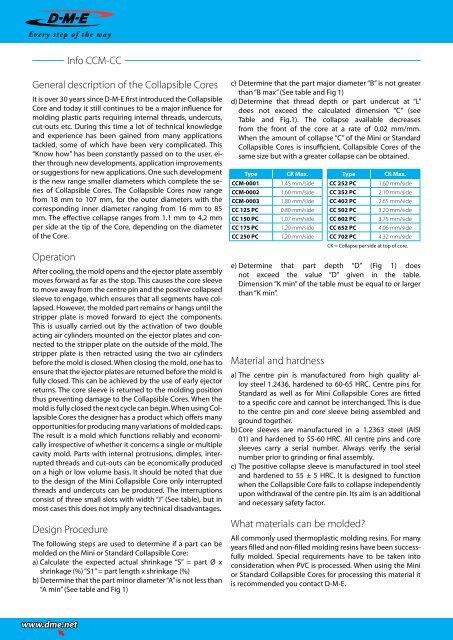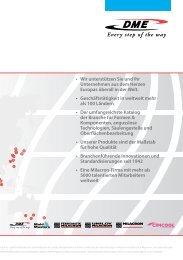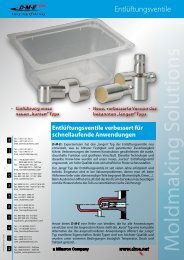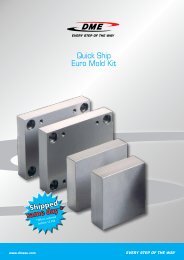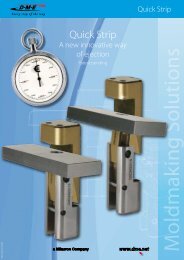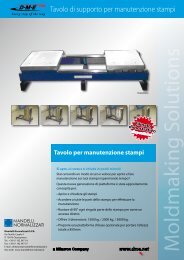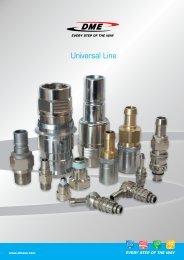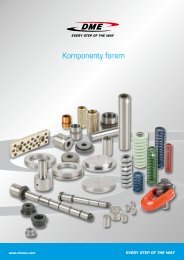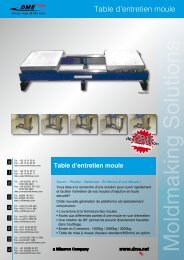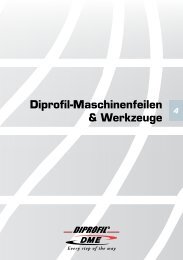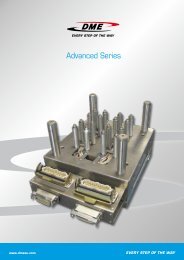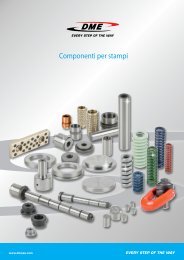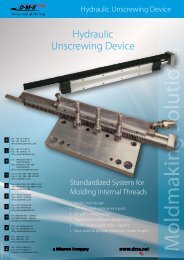Collapsible Core - DME
Collapsible Core - DME
Collapsible Core - DME
Create successful ePaper yourself
Turn your PDF publications into a flip-book with our unique Google optimized e-Paper software.
Info CCM-CCGeneral description of the <strong>Collapsible</strong> <strong>Core</strong>sIt is over 30 years since D-M-E first introduced the <strong>Collapsible</strong><strong>Core</strong> and today it still continues to be a major influence formolding plastic parts requiring internal threads, undercuts,cut-outs etc. During this time a lot of technical knowledgeand experience has been gained from many applicationstackled, some of which have been very complicated. This“Know how” has been constantly passed on to the user, eitherthrough new developments, application improvementsor suggestions for new applications. One such developmentis the new range smaller diameters which complete the seriesof <strong>Collapsible</strong> <strong>Core</strong>s. The <strong>Collapsible</strong> <strong>Core</strong>s now rangefrom 18 mm to 107 mm, for the outer diameters with thecorresponding inner diameter ranging from 16 mm to 85mm. The effective collapse ranges from 1.1 mm to 4,2 mmper side at the tip of the <strong>Core</strong>, depending on the diameterof the <strong>Core</strong>.OperationAfter cooling, the mold opens and the ejector plate assemblymoves forward as far as the stop. This causes the core sleeveto move away from the centre pin and the positive collapsedsleeve to engage, which ensures that all segments have collapsed.However, the molded part remains or hangs until thestripper plate is moved forward to eject the components.This is usually carried out by the activation of two doubleacting air cylinders mounted on the ejector plates and connectedto the stripper plate on the outside of the mold. Thestripper plate is then retracted using the two air cylindersbefore the mold is closed. When closing the mold, one has toensure that the ejector plates are returned before the mold isfully closed. This can be achieved by the use of early ejectorreturns. The core sleeve is returned to the molding positionthus preventing damage to the <strong>Collapsible</strong> <strong>Core</strong>s. When themold is fully closed the next cycle can begin. When using <strong>Collapsible</strong><strong>Core</strong>s the designer has a product which offers manyopportunities for producing many variations of molded caps.The result is a mold which functions reliably and economicallyirrespective of whether it concerns a single or multiplecavity mold. Parts with internal protrusions, dimples, interruptedthreads and cut-outs can be economically producedon a high or low volume basis. It should be noted that dueto the design of the Mini <strong>Collapsible</strong> <strong>Core</strong> only interruptedthreads and undercuts can be produced. The interruptionsconsist of three small slots with width “J” (See table), but inmost cases this does not imply any technical disadvantages.Design ProcedureThe following steps are used to determine if a part can bemolded on the Mini or Standard <strong>Collapsible</strong> <strong>Core</strong>:a) Calculate the expected actual shrinkage “S” = part Ø xshrinkage (%) “S1” = part length x shrinkage (%)b) Determine that the part minor diameter “A” is not less than“A min” (See table and Fig 1)c) Determine that the part major diameter “B” is not greaterthan “B max” (See table and Fig 1)d) Determine that thread depth or part undercut at “L”does not exceed the calculated dimension “C” (seeTable and Fig.1). The collapse available decreasesfrom the front of the core at a rate of 0,02 mm/mm.When the amount of collapse “C” of the Mini or Standard<strong>Collapsible</strong> <strong>Core</strong>s is insufficient, <strong>Collapsible</strong> <strong>Core</strong>s of thesame size but with a greater collapse can be obtained.TypeCCM-0001CCM-0002CCM-0003CC 125 PCCC 150 PCCC 175 PCCC 250 PCCK Max.1.45 mm/side1.60 mm/side1.80 mm/side0.80 mm/side1.07 mm/side1.20 mm/side1.20 mm/sidee) Determine that part depth “D” (Fig 1) doesnot exceed the value “D” given in the table.Dimension “K min” of the table must be equal to or largerthan “K min”.Material and hardnessTypeCC 252 PCCC 352 PCCC 402 PCCC 502 PCCC 602 PCCC 652 PCCC 702 PCa) The centre pin is manufactured from high quality alloysteel 1.2436, hardened to 60-65 HRC. Centre pins forStandard as well as for Mini <strong>Collapsible</strong> <strong>Core</strong>s are fittedto a specific core and cannot be interchanged. This is dueto the centre pin and core sleeve being assembled andground together.b) <strong>Core</strong> sleeves are manufactured in a 1.2363 steel (AISI01) and hardened to 55-60 HRC. All centre pins and coresleeves carry a serial number. Always verify the serialnumber prior to grinding or final assembly.c) The positive collapse sleeve is manufactured in tool steeland hardened to 55 ± 5 HRC. It is designed to functionwhen the <strong>Collapsible</strong> <strong>Core</strong> fails to collapse independentlyupon withdrawal of the centre pin. Its aim is an additionaland necessary safety factor.What materials can be molded?CK Max.1.60 mm/side2.10 mm/side2.65 mm/side3.20 mm/side3.75 mm/side4.06 mm/side4.32 mm/sideCK = Collapse per side at top of core.All commonly used thermoplastic molding resins. For manyyears filled and non-filled molding resins have been successfullymolded. Special requirements have to be taken intoconsideration when PVC is processed. When using the Minior Standard <strong>Collapsible</strong> <strong>Core</strong>s for processing this material itis recommended you contact D-M-E.www.dme.net


